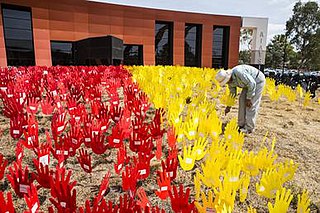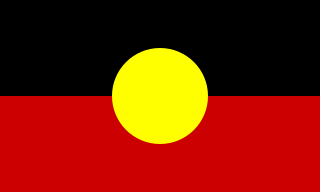
The Australian Institute of Aboriginal and Torres Strait Islander Studies (AIATSIS), established as the Australian Institute of Aboriginal Studies (AIAS) in 1964, is an independent Australian Government statutory authority. It is a collecting, publishing, and research institute and is considered to be Australia's premier resource for information about the cultures and societies of Aboriginal and Torres Strait Islander peoples.

Norman Barnett Tindale AO was an Australian anthropologist, archaeologist, entomologist and ethnologist. He is best remembered for his work mapping the various tribal groupings of Aboriginal Australians at the time of European settlement, shown in his map published in 1940. This map provided the basis of a map published by David Horton in 1996 and widely used in its online form today. Tindale's major work was Aboriginal Tribes of Australia: Their terrain, Environmental Controls, Distribution, Limits and Proper Names (1974).

Aboriginal Australians are the various Indigenous peoples of the Australian mainland and many of its islands, excluding the ethnically distinct people of the Torres Strait Islands.
Indigenous Australians are people with familial heritage from, and/or recognised membership of, the various ethnic groups living within the territory of present day Australia prior to British colonisation. They consist of two distinct groups, which include many ethnic groups: the Aboriginal Australians of the mainland and many islands, including Tasmania, and the Torres Strait Islanders of the seas between Queensland and Papua New Guinea, located in Melanesia.

Australian studies forms part of the academic field of cultural studies. It involves an examination of what constructs Australia's national identity. This area of scholarship traditionally involves the study of Australian history, society and culture but can be extended to the study of Australian politics and economics. This area of scholarship also includes the study of Australia's Indigenous population, Aboriginals and Torres Strait Islanders.
Indigenous Australian customary law or Indigenous Australian customary lore refers to the legal systems and practices uniquely belonging to Indigenous Australians of Australia, that is, Aboriginal and Torres Strait Islander people.

Kanyaka Station was a cattle and sheep station in the Flinders Ranges of South Australia located at Kanyaka, approximately 40 km (25 mi) north-north-east of Quorn, South Australia. along Hawker-Stirling North Road (B83).

Maroochy Barambah is an Australian Aboriginal mezzo-soprano singer. She is a song-woman, law-woman and elder of the Turrbal people.
Natascha Duschene McNamara is an Ngarrindjeri Australian academic, activist, and researcher. She co-founded the Aboriginal Training and Cultural Institute in Balmain, New South Wales and served as President of the Aboriginal Children's Advancement Society Ltd. Her affiliations include: Fellowship, Centre of Indigenous Development Education and Research, University of Wollongong ; member, Australian Press Council; and Member, Australian Institute of Aboriginal and Torres Strait Islander Studies Council.
Dhauwurd Wurrung is a term used for a group of languages spoken by various groups of the Gunditjmara people of the Western District of Victoria, Australia. Keerray Woorroong is regarded by some as a separate language, by others as a dialect. The dialect continuum consisted of various lects such as Kuurn Kopan Noot, Big Wurrung, Gai Wurrung, and others. There was no traditional name for the entire dialect continuum and it has been classified and labelled differently by different linguists and researchers. The group of languages is also referred to as Gunditjmara language and the Warrnambool language.
Mbara, and Yanga are mutually intelligible but separate Aboriginal language of Queensland, both now extinct. Glottolog assigns a code to a group level as Mbara-Yanga (mbar1254). Yanga is not to be confused with the Yangga language, a dialect of Biri.
Wanggamala, also spelt Wanggamanha, Wangkamahdla, Wangkamadla, Wangkamanha, Wangkamana, Wonkamala, Wongkamala, Wonkamudla, and other variants, is an extinct Australian Aboriginal language of the Pama–Nyungan family, previously spoken in the Northern Territory around Hay River and to the south of the Andegerebinha-speaking area.
Gkuthaarn, also rendered Kuthant, Kutanda and other variant spellings, is an extinct Paman language of the Cape York Peninsula, Queensland, Australia. It also known as Karundi/Garandi, but the Garandi language may be a separate dialect.

The Wadandi, also spelt Wardandi and other variants, are an Aboriginal people of south-western Western Australia, one of fourteen language groups of the Noongar peoples.
The Njakinjaki are an indigenous Noongar people of southern Western Australia, in the Wheatbelt and Great Southern regions.
The Dingaal people, also known as Walmbarddha or Walmbaria, are an Aboriginal Australian people of Cape York Peninsula in northern Queensland.
The Kuyani people, also written Guyani and other variants, and also known as the Nganitjidi, are an Aboriginal Australian people of the state of South Australia who speak the Kuyani language. Their traditional lands are to the west of the Flinders Ranges.
The Yangkaal, also spelt Yanggal, are an Aboriginal Australian people of area of the Gulf of Carpentaria in the state of Queensland.
David Robert Horton is an Australian writer with qualifications and careers in science and the arts. He is known for his compilation of the work The Encyclopaedia of Aboriginal Australia: Aboriginal and Torres Strait Islander history, society and culture in 1994, and its accompanying map of Aboriginal groupings across Australia.







